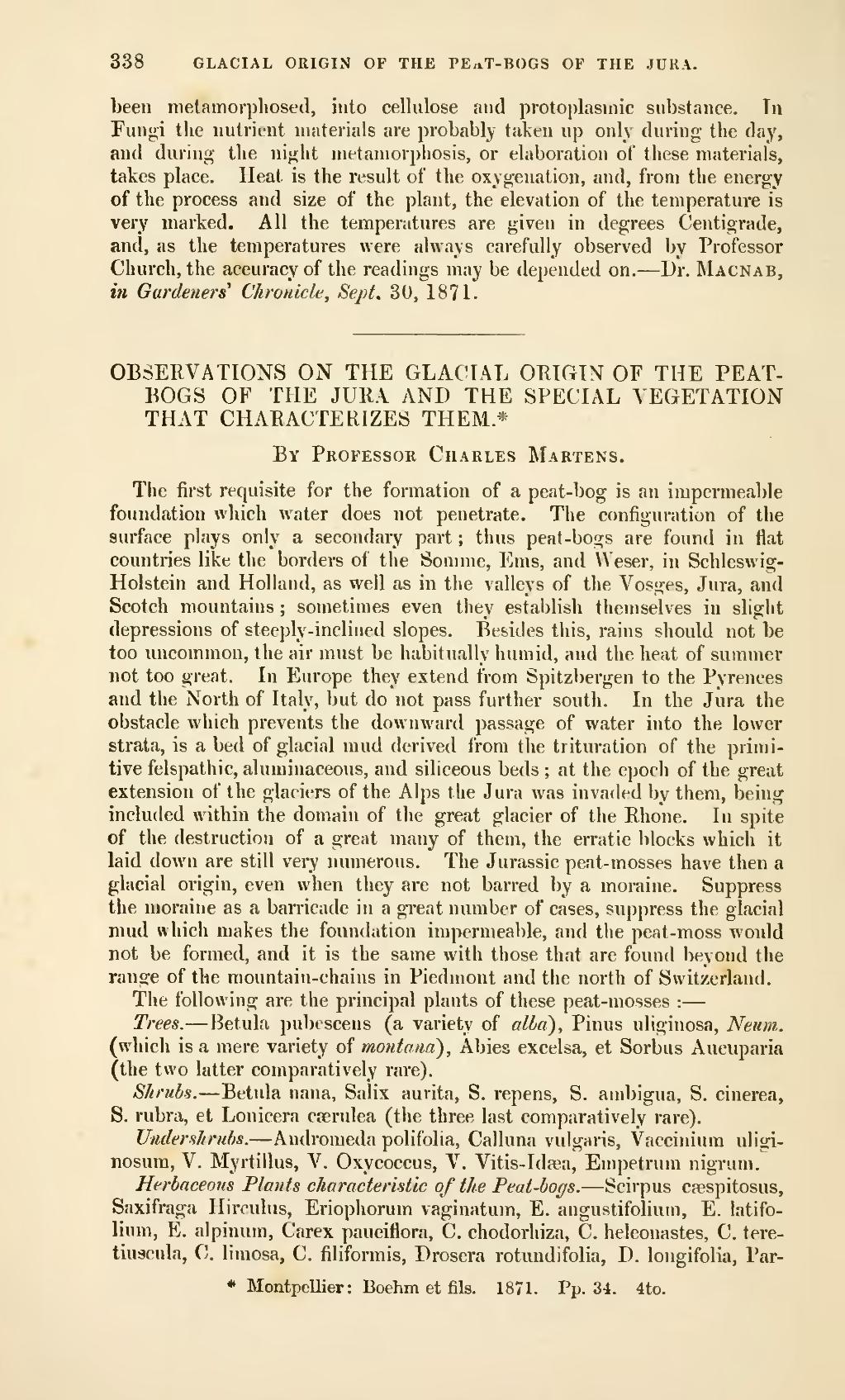338 GLACIAL ORIGIN OF THE PE.iT-BOGS OF THE JURA.
been metamorphosed, into cellulose and protoplasmic substance. In Fungi the nutrient materials are probably taken up only during- the day, and during the night metamorphosis, or elaboration of these materials, takes place. Heat is the result of the oxygenation, and, from the energy of the process and size of the plant, the elevation of the temperature is very marked. All the temperatures are given in degrees Centigrade, and, as the temperatures were always carefully observed by Professor Church, the accuracy of the readings may be depended on. — Dr. Macnab, i?i Gardeners' Chronicle, Sept, 30, 1871.
��OBSERVATIONS ON THE GLACIAL ORIGIN OF THE PEAT- BOGS OF THE JURA AND THE SPECIAL A^EGETATION THAT CHARACTERIZES THEM.*
By Professor Charles Martens.
The first requisite for the formation of a peat-bog is an impermeable foundation which water does not penetrate. The configuration of the surface plays only a secondary part; thus peat-bogs are found in fiat countries like the borders of the Somme, Ems, and Weser, in Schleswig- Holstein and Holland, as well as in the valleys of the Vosges, Jura, and Scotch mountains; sometimes even they establish themselves in slight depressions of steeply-inclined slopes. Besides this, rains should not be too uncommon, the air must be habitually humid, and the heat of summer not too great. In Europe they extend from Spitzbergen to the Pyrenees and the North of Italy, but do not pass further south. In the Jura the obstacle which prevents the downward passage of water into the lower strata, is a bed of glacial mud derived from the trituration of the primi- tive felspathic, aluminaceous, and siliceous beds; at the epoch of the great extension of the glaciers of the Alps the Jura was invaded by them, being included within the domain of the great glacier of the Rhone. In spite of the destruction of a great many of them, the erratic blocks which it laid down are still very numerous. The Jurassic peat-mosses have then a glacial origin, even when they are not barred by a moraine. Suppress the moraine as a barricade in a great number of cases, suppress the glacial mud which makes the foundation impermeable, and the peat-moss would not be formed, and it is the same with those that are found beyond the range of the mountain-chains in Piedmont and the north of Switzerland.
The following ai'c the principal plants of these peat-mosses: —
Trees. — Betula pubescens (a variety of alba), Pinus uliginosa, Nenm. (which is a mere variety of montana'), Abies excelsa, et Sorbus Aucuparia (the two latter comparatively rare).
Shrubs. — Betula nana, Salix aurita, S. repens, S. ambigua, S. cinerea, S. rubra, et Lonicera cferulea (the three last comparatively rare).
Under shrubs. — Andromeda polifolia, Calluna vulgaris, Vacciniura uligi- nosum, V. Myrtillus, V. Oxycoccus, V. Vitis-Idaea, Empetrum nigrum.
Herbaceous Plants characteristic of the Peat-bogs. — Scirpus caespitosus, Saxifraga Hirculus, Eriophorum vaginatum, E. angustifolium, E. latifo- lium, E. alpinura, Carex pauciflora, C. chodorhiza, C. heleonastes, C. tere- tiuscula, C. limosa, C. filiformis, Drosera rotundifolia, D. longifolia, Par-
- Montpellier: Boehm et fits. 1871. Pp.34. 4to.
�� �
